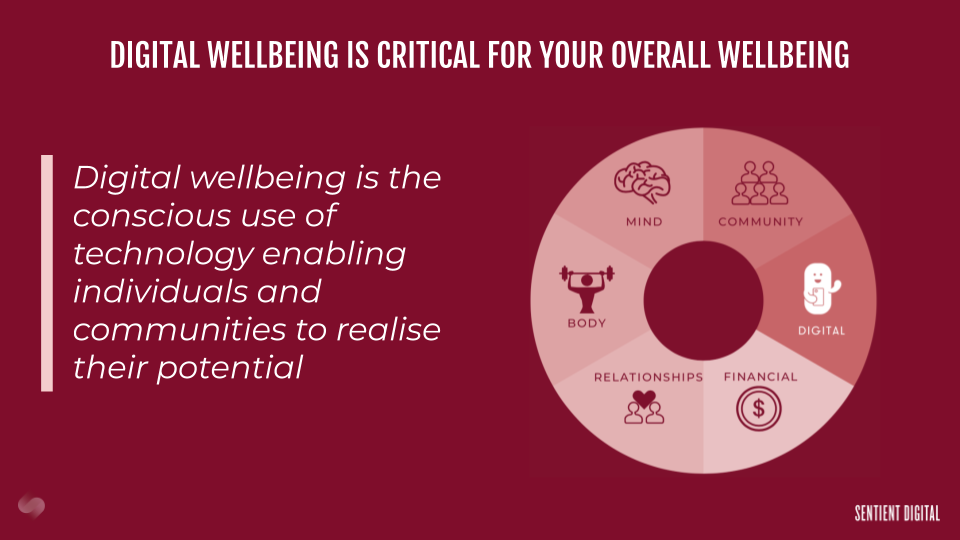What is Digital Wellbeing? Defining a Framework to help you find it.
Digital Wellbeing, is a term that has been gaining momentum over the past few years. And it’s become even more relevant since the coronavirus pandemic has forced our lives online. We are alone together – and more connected than ever before. This acceleration of online interaction has led many of us to reflect on our relationships with technology, the value that it brings, and the role it plays in the lives of our loved ones.
But what actually is Digital Wellbeing? And how can we incorporate it into our daily routines?
At Sentient Digital we have defined Digital Wellbeing as “the conscious use of technology which enables individuals and communities to realise their potential”. In other words, Digital wellbeing is about how we engage with technology, how we use it to make us better.
Digital Wellbeing is a category of wellbeing in its own right, fitting into the broader spectrum of wellbeing in general. It is as important as our mental, physical, and financial wellbeing, and interconnects with all the other areas of our overall wellness. Like good physical health improves our mental health, our digital habits can improve our physical and mental health, our relationships, and much more.
You can see how digital fits into the different areas of wellbeing in the Digital Wellbeing Wheel below.
You might now be asking yourself what it takes to achieve good digital wellbeing, or if you even have time to worry about it. But it doesn’t have to be complicated. We came up with a model to help people easily identify their current digital habits, and understand their own responsibilities. The 4Cs of Digital Wellbeing is a simple method that can help you keep your tech use mindful, productive, and enjoyable.
Control: When we use technology and whether it is on our terms
Are you using technology consciously or is the way you use technology a habit?
Are you spending time on screens which could be better spent doing something else (like sleeping, eating with your family, or even just being bored)?
Are you in control of the digital products you are using? Do you agree with the terms and conditions of the product?
Connection: How and where we access technology, the personal financial cost and the opportunity “cost”
What is the economic cost of being online? Can you afford the connection and your devices?
What is the financial value of your interactions online?
Is there an opportunity cost of being online? Is distraction reducing your productivity?
Content: What we consume or contribute online. How we communicate and build relationships and communities
What are you reading, digesting, or receiving from being online? Does it make your life better?
Is the content trustworthy, reliable, and balanced? Or fake and biased?
What are you contributing to online? Are you portraying your true self?
Care: Noticing the impact of these technology habits on our own social, mental, and physical wellbeing.
Are you able to take a step back to assess the overall value of how you are using technology in your life?
Can you define the pros and cons?
Does the way you are using technology support your values and make your life better?
The end goal of Digital Wellbeing is to consciously connect with technology so that we can maximize its positives while minimizing its negatives. If we follow the 4 Cs method when we interact with technology by constantly questioning our choices, we will be able to enjoy all the benefits that the digital world has to offer, and ensure that our children grow up to enjoy a healthy relationship with technology too.
At Sentient Digital our goal is to return autonomy to users so that they might get the most from their use of technology. We do this through corporate, family and individual education, and by encouraging the responsible tech movement towards a more transparent tech landscape. Reach out if you’d like to discuss more!


